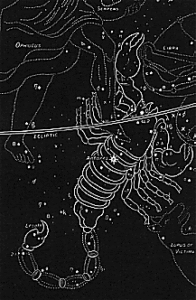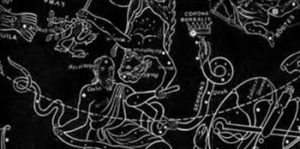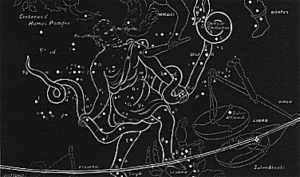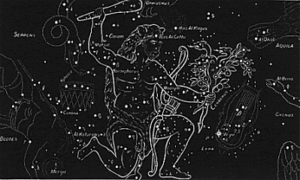Scorpio: The Attack of the Enemy
Chapter Three: The Redeemer’s Conflict
We now enter the heart of the conflict. The heavens picture a huge scorpion trying to sting the heel of a mighty man who is struggling with a snake, but is crushed by the man, who has His foot planted squarely on the scorpion’s heart. In the second book, the Church is seen in conflict with the enemy.
The Hebrew name is Akrab, which is the name of the scorpion, but it also means the conflict, or war. David uses this very word in Psalm 144:1, where he praises ADONAI my Rock, who trains my hands for war, my fingers for battle. The Coptic name is Isidis, which means the attack of the enemy, or oppression, which refers to the wicked who assail me, from my mortal enemies who surround me (Psalm 17:9). The Arabic name is Al Akrab, which means wounding him that comes. The brightest star alpha marks the heart of the scorpion and bears the ancient Arabic name of Antares, which means the wounding. It shines with a deep red light. In Hebrew, the stinger is called lesath, which means the perverse.

We learn from the John that the scorpion is a deadly enemy (see my commentary on Revelation, to see link click Da – The Fifth Trumpet: Locusts Came Down Upon the Earth and Were Given Power Like That of Scorpions). The poison sting symbolizes the hostility between the serpent and the Seed of the woman. That hate is seen more clearly in Exodus 1:16-22, where the enemy attempts to destroy every male child of the seed of Abraham and how that evil plan was defeated. We see the effort repeated when the serpent used Athaliah to destroy the whole royal family (Second Kings 11:1-3), and how the king’s son was rescued away from among the royal princes, who were about to be murdered. The scene is repeated in Esther, where the wicked Haman, the enemy of the Jews (Esther 9:1), tried to destroy the entire nation, but he was defeated. When the woman’s Seed was born, Satan prompted Herod to kill all the boys in Bethlehem and its vicinity who were two years old and under (Matthew 2:16), but again he was defeated. During the forty days in the Judean desert and at Yeshua’s religious trial, the great conflict was renewed. He told His enemies: This is your hour – when darkness reigns (Luke 22:53b). And the battle raged right up until the time when the scorpion struck the woman’s Seed. The real wounding in the heel took place at the cross. Jesus Christ died, but was raised again from the dead to settle the conflict forever.

1. and 2. Serpens (The Serpent) and Ophiuchus (The Serpent Holder): Here Serpens, the serpent, is seen on the right in the grasp, and struggling in vain with a man who is named Ophiuchus below left. In Latin the serpent is called Serpentarius. At the same time Ophiuchusis seizing the serpent with both hands; he is stepping on the very heart of the scorpion, marked by the deep red star Antares, but at the same time the scorpionis trying to wound his heel and seize the crown, which is just over his head. This is the ultimate struggle in the universe. It was the Adversary, in the form of a serpent that robbed the first Adam of his crown, but struggled in vain to wrestle the crown away from the last Adam (First Corinthians 15:45), and not only does he fail in this attempt, but is himself utterly defeated and destroyed (Revelation 20:10).

The brightest star alpha in the neck of the Serpent is named Unuk, which means surrounding. Another Hebrew name is Alyah, the accursed. The Arabic name is Al Hay, the reptile. The next brightest star beta in the neck of the Serpent is named in Arabic, Chelb or Chelbalrai, the serpent enfolding. The Greek name Ophiuchus is itself from the Hebrew and Arabic name Afeichus, which means the serpent held. All these show us the magnitude of this great struggle, but the outcome of this struggle is seen by the last of the three constellations of this chapter. The mighty Man is the victor!

3. Hercules (The Mighty Man): Each chapter ends in victory and here the mighty One, who occupies a large portion of the heavens, is seen bending on one knee, with the right heel lifted up as if it had been wounded, while the left foot is set directly over the head of the great dragon. In his right hand he wields a great club and in his left hand he grasps a triple headed snake monster named Cerberus. It is easy to see how the perversion of the truth of the gospel by the Greeks came about, and how, when the truth had been lost, that other fables were invented to replace them. There were some Greeks who understood this. Aristotle, in his Metaphysics, 10.8, admits that religion and philosophy had been lost and that much had been “added after the mythical style.” Therefore, ancient authorities differed about the personality of Hercules and the order of what are sometimes called “the twelve labors of Hercules”, but there can be no doubt as to the mighty works that the Seed of the woman would perform.
At every turn Hercules is seen destroying the enemy: now it is the Nemean lion, then it is the slaughter of the boar of Erymanthus, again, it is the conquest of the bull of Crete, next the killing of the three headed Hydra, whose venom eventually kills Hercules. Then he is said to have remained in the belly of the sea three days and three nights, only to rise again. This was doubtless a distortion of the story of Jonah and the whale (see my commentary on Jonah Aq – Jonah and the Great Whale). So when we see Hercules overthrowing enormous enemies and delivering captives, we can see ADONAI at work also. We can perceive how the original intent of “the old, old story” in the stars would show the wielding of His great club, victorious over all His enemies, and planting His foot on the Serpent’s head.
When the enemy attacks, God is our refuge. Psalm 91 spells this out for all of us: We trust in God, therefore, He is our refuge and our fortress. This psalm combines the warm protectiveness of a parent bird (He covers us with His feathers, and under His wings we find refuge) with the hard, unyielding strength of armor (His faithfulness is our shield). The psalmist assures us that ADONAI is our refuge because He will command His angels to guard us in all our ways. It is the LORD that goes before us to tread upon the lion and the cobra; the young lion and the serpent He will trample under foot.
The psalm ends with three simple truths. First, because we love ADONAI, He says that He will rescue us. Secondly, because we acknowledge His name, we will call on Him, and He will answer. Thirdly, God promises to be with us in times of trouble, that He will deliver us and honor us. At its lowest common denominator, our bond with the LORD is between the Helper and the helpless. It is a matter of grace. When the attack of the enemy comes, we need to remember that the Mighty Man says: With long life will I satisfy [them] and show [them] My salvation (Psalm 91:16). This is the witness of the stars.



Leave A Comment